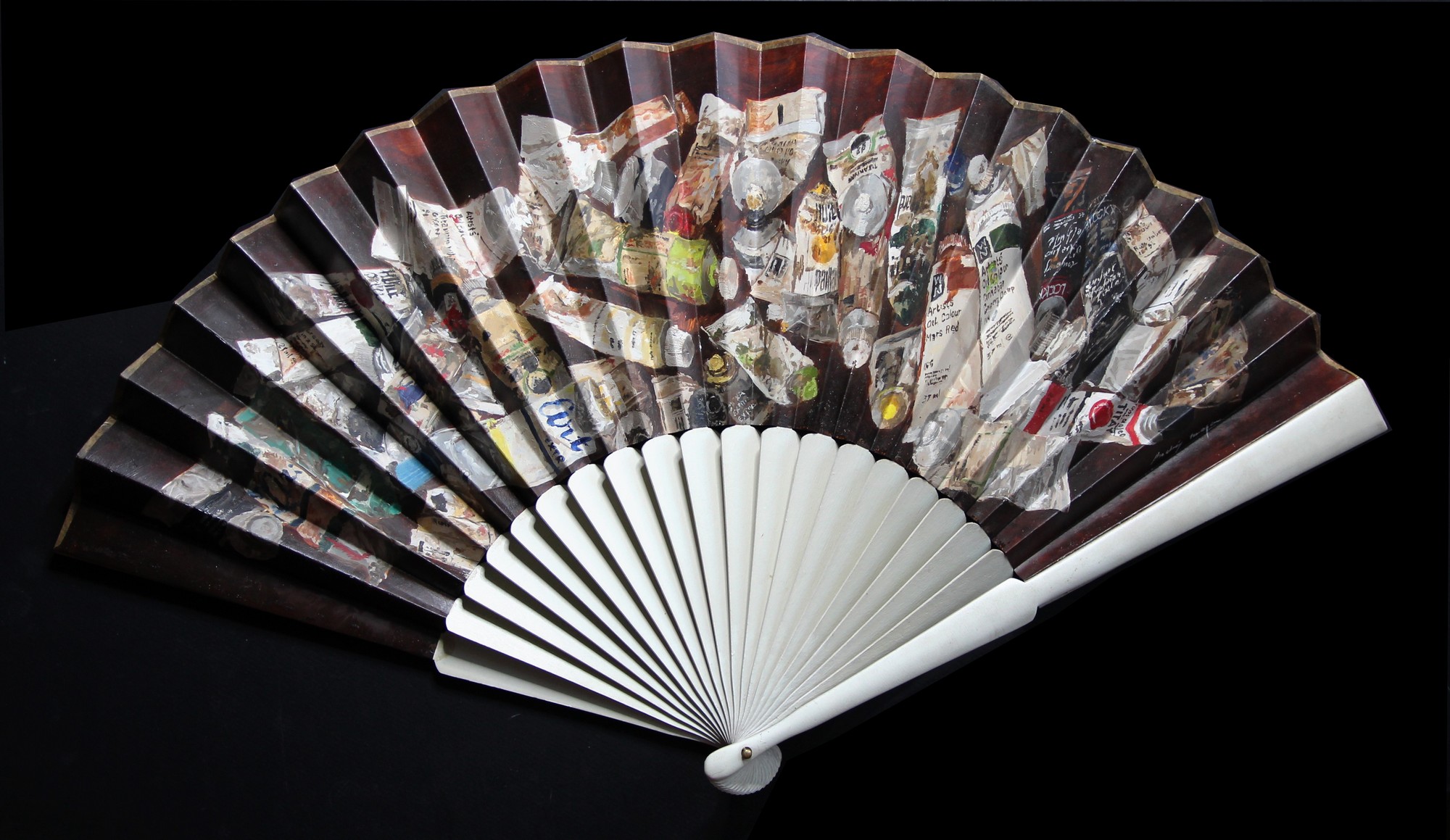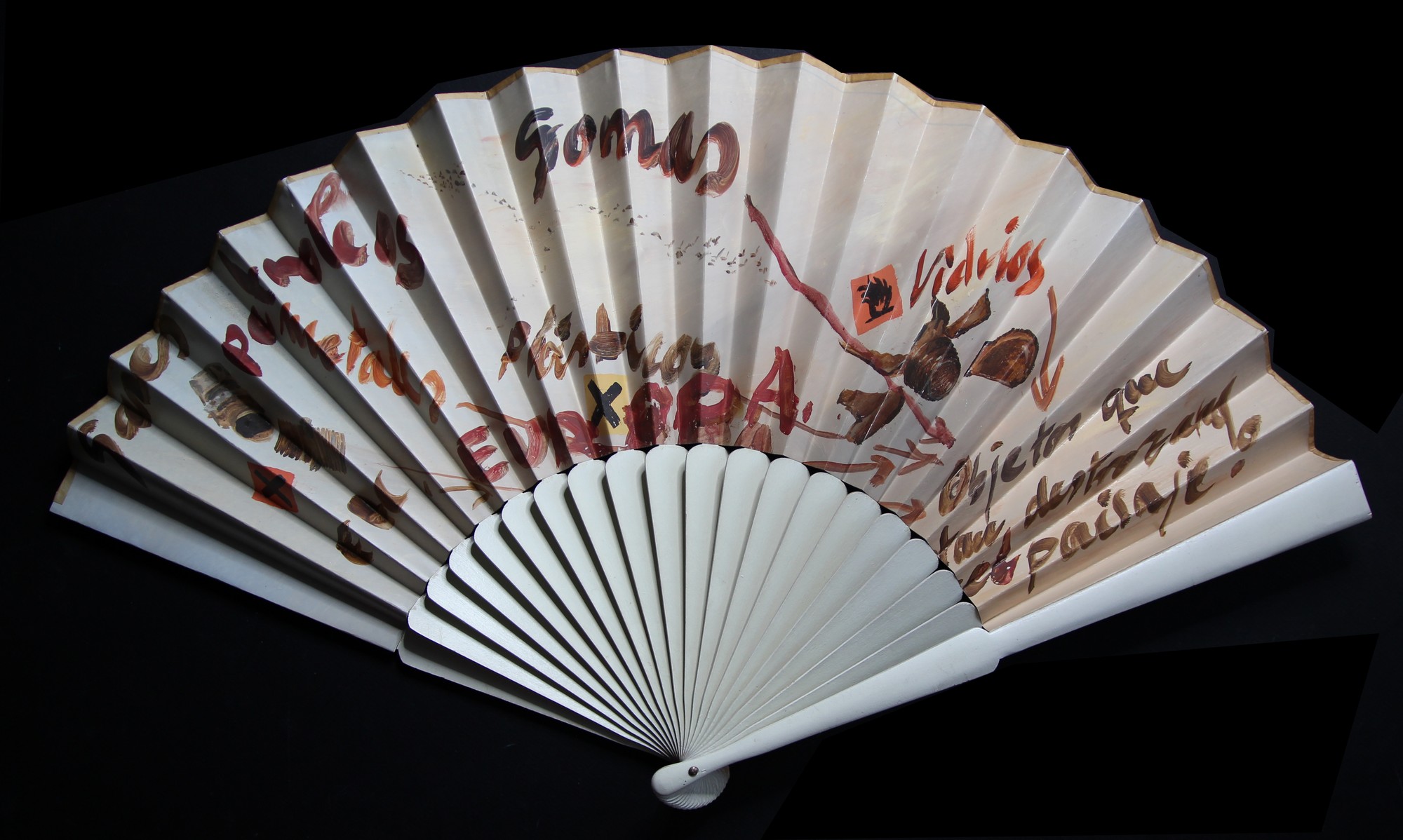Nineteenth-century authors readily let
believe that Watteau, Boucher, Le Brun and other famous painters of the
seventeenth and eighteenth centuries did paint fans. If it was, it was
extremely rare. In the 19th century, on the other hand, we know that a
number of artists, in particular under the influence of Japonism and
Impressionism, appreciated the restrictive but new format of the fan
leaf and produced either real fan leaves that could be mounted, or
works in the shape of a fan. In this regard, we can have a useful
look at Anne Sefrioui's Les
Éventails Impressionnistes (Citadelles et Mazenod, Paris, 2012).
Fan fans know that fan makers at the start of the 21st century
sometimes call on more or less consecrated artists to decorate fan
leaves, especially printed ones. They also know that both the Musée de
l'Eventail-Hoguet in Paris and the Fan Museum in London obtained the
collaboration of extremely modern "Street-Art" artists for interesting
and successful exhibitions. We can also quote an exhibition organisez (end of 2018) by Serge Davoudian (https://www.marchebiron.com/actualites/expositions/item/11919-double-exposition-organisee-par-serge-davoudian-du-1er-decembre-2018-au-14-janvier-2019-au-marche-biron). But we rarely talk about an
exhibition which in 1995 brought together 113 contemporary artists who
had agreed to make original fans (even if some were later printed). It
is even difficult, although many of these artists who are still happily
active mention it in their biography, to locate and date this
exhibition precisely ... and even fans of fans who have been able to
visit this exhibition do not do so spontaneously. Fortunately, one of
the artists is precise and indicates, for this year 1995, his
participation in "Eventails
d'Artistes ", Galerie La Pochade, Paris, France, May 18
(opening); Espace Riquet, Béziers, France, July 12 - September 10 ”.
The exhibition was accompanied by a small booklet titled Eventails d'Artistes Contemporains,
reproducing all the works and giving the names of the authors, but
without dates of exhibition or publication. However, it was indicated
on the back of the booklet: "Exhibition based on an idea from the
Galerie La Pochade - Paris". This Parisian gallery, created in 1962 at
157 boulevard Saint-Germain migrated later to 11 rue Guénégaud before
disappearing in 1999 and then reappearing in the Village Suisse (avenue
Suffren).
The exhibition was presented with a short preface by Laurent Gally. He
specified: "For the renewal of the art of the fan, it has been [...]
proposed to the artists to write on the back of their works a quotation
or a short poem in praise of the fan" and concluded "True museum
pieces, these fans are also works of art sought after by all
collectors". We would therefore have expected, more than a quarter of a
century after the exhibition, to see many of these works on display in
museums or offered for sale in art galleries or auction rooms, but this
is not the case.
However, we see on the Paris Galliéra museum website:
- a fan entitled "The Child with the
Bird" (https://www.parismuseescollections.paris.fr/fr/palais-galliera/oeuvres/enfant-a-l-oiseau#infos-principales). This work (1998.128.3) was produced by
Alékos Fasianós, (Athens, 13–12–1935), strangely described by Galliéra
as a "fan painter". Here you will find some information and other examples of this
artist's work. This fan is number 2 in the Galerie La Pochade catalog;
- a printed fan by the well-known artist Ben (Benjamin Vautier, said-,
18–07–1935), with various cursive inscriptions on the recto, including
in large letters: "Je t'aime" (2000.215.1) (https://www.parismuseescollections.paris.fr/fr/palais-galliera/oeuvres/je-t-aime#infos-principales). This fan corresponds to fan n ° 4 in the
La Pochade catalog. However, in this catalog the fan
is an original and has a reverse marked: "I hate you". Known from 1959
for his "tote shop, meeting place and exhibition", Ben is one of the
founders of the Fluxus movement. For him, everything is art and
everything is possible in art. He is known in particular for his
performances and his calligraphic aphorisms-writings, available in
various media, of which this fan is an example.
While several artists who took part in this exhibition cite it in the
list of those in which they participated, it was not possible for us to
find other fans, or even reproductions of better quality than those
appearing in the catalog. There is, however, one exception that we want
to share with you here. It is, in the Galerie La Pochade catalog, number 52.

This 33 cm fan consists of a wooden monture
(18 adjoining sticks + 2) painted white with a 17 cm double leaf
painted in oil by the Catalan artist Andrés Moya, born in 1964, who has
exhibited in numerous galleries and museums, notably in Spain and
France. He has lived in Barcelona for over thirty years. As indicated
by a presentation of his last exhibition (early 2020) "Il somni d'Icar", he works on
issues that concern him, such as the society consumerism and the
accumulation of waste that endangers the live of the planet or the
initiation into violence for the little ones through toy guns:
"innocent water guns that we associate with summer games, but which
have a perverse background", he declared. The above fan, although
relatively old in his work, is entirely in this line, since it
represents the waste that the painter himself produces, with this set
of crushed tubes, often not closed, that we imagine abandoned and dried
up, destined to be thrown away and perhaps to pollute nature.
The message of the work is even better marked by the reverse side of
the fan. In the auction where this fan was acquired, it was announced:
"on the back of the words chosen by the artist in praise of the fan".
But you don't have to be a Hispanist to understand that the sentences
or words we see have nothing to do with the qualities of fans. It is in
fact written from left to right: "Gases
- Petroleos - metalles - Gomas - Plasticos - Vidrios - etc" and "Europa" These words are accompanied
by the schematic representation of a tube of paint and conventional
signs indicating the danger of toxic products and of flammable
products. A sentence on the right, indicated by arrows crossing the
leaf, summarizes the message: "objetos
que tan destrozan el paisaje".
A translation is hardly necessary. Let us give it however: "Gas - Oil -
Metals - Rubber - Plastics - Glass -etc"; "Europe"; "objects that
destroy the landscape so much". The proclamation is explicit. Long
before Green fashion, it was about the recognition of the damage caused
to the environment by chemicals and others, and in particular those
used by painters. It is, in a way, a self-portrait of the artist as a
polluter!

Here is an article (in Catalan: quite easy to
understand if you know Spanish and / or French ...) about one of Andrés
Moya's last exhibitions.
Leaving this highly significant and precursor hand
fan, typical of the artist's production, we come back to our question
... or rather to our questions.
What questions?
You are
perhaps the proud owner of one of the fans featured in the 1995
exhibition at La Pochade (Paris) and at the Espace Riquet in Béziers.
Maybe you've seen some in museums or at auctions?
To help you, here is in alphabetical order (which is not that of the
catalog) a list of the 113 artists (today very well known, little known
or unknown!) whose fans were then exhibited:
Aeschbacher - Aizpiri -
Agosti - Arnal - H Arthur Bertrand -
Baruchello - Baugeste -
Bellegarde - Ben - Bertini - Beyneto - Bitran - Boiry - Bonhomme -
Brasilier - Busca - Byzantios - Cassigneul - Canovas - Chambard -
Chambas - CharlElie - Ph.
Charpentier - Chu Teh Chun -
Yves
Clerc - Clerte - Jean Cocteau
- Annie Cohen - Combas - Cortot - Courtin - Couturier - Cremonini -
Cueco - Olivier Debré - Alexandre Delay -
Dumesnil - Duvillier - Erro - Fanti - Fassianos - Feito - Feraud -
Ferrer - Fromanger - Gardy Artigas - Oscar Gauthier - Gillet -
Gripekoven - Etienne Gros - Guiramand -
Guitet - Guyomard -
Hambourg - Heinzen - Michel Henricot
- Francis Herth - Daniel Humair - Kalfas -
Kantoriwicz
- Koenig - Kijno - Klasen - Tchang Yeul Kim - Kriki - Laubies - Le Bars
- Leboulc'h - Le Yaouanc - Licata - Ljuba - Lozano - Martine Martine - Mesnager -
Mesterou
- Milkovitch - Jean Miotte -
Miss Tic - Mitrofanoff - Monory - Mosner - Andres Moya - Kajean - Noel
- Novellas - Olivier Olivier - Pera -
Pillet - Piza - Bernard Quentin - Rancillac - Jean-Pierre Rives - Rueda -
Schoendorff - Schlosser -
Segui - Seun Ja Rhee - Denis Rivière
- Luc Simon - Anne-Marie Soulcie - Stämpfli -
Steffens
- Syroka - Taule - Todie -
Alain Trez
- Tyzsblat - Velickovic - Bernar
Venet - Venturelli -
Wunderlich - Yankel - Xenakis.
Merci d'avance pour vos contributions. Bien entendu, tous
autres avis, opinions ou questions sont bienvenus !
|